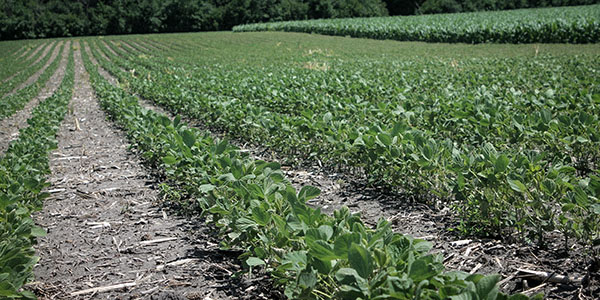AGRONOMICSUPPORT
YOU CAN TAKETO THE FIELD
Using Fungicides for High-Yielding Soybeans
Fungicides can be an important part of high yields in soybeans. As soybean profits are near all-time highs, farmers need to evaluate and make the correct management decisions for applying fungicides to suppress plant disease and increase soybean yields. This article addresses how and when to apply fungicides to optimize your soybean yields and distinguishing what is an “expense” and what is an “investment” in your growing crop.
The first way to utilize fungicides on soybeans is with a soybean seed treatment. Every year, soybean seed treatments are utilized as the first defense against yield-robbing soybean diseases. The main diseases farmers need to protect against are pythium, fusarium, and rhizoctonia (Poag et al., 2005). Each of these diseases reduce soybean stands by decreasing their vigor, which can reduce plant stands. Fungicide seed treatments allow farmers to plant earlier and provide a barrier against seedling diseases. Increased plant stands provide added yield potential as well as an increased number of pods and soybeans per acre (Cox and Cherney, 2014).
Foliar fungicides have also shown a positive yield response at R3. A few of these yield-robbing diseases are frogeye leaf spot, anthracnose and brown stem rot. Each of these diseases can be managed either through plant tolerance, and/or the use of a foliar fungicide. The best timing for the greatest effectiveness against these diseases is to apply foliar fungicides at the R3 growth stage of soybeans (Poag et al., 2005). R3 is reached when the soybean plant has any pod that is 3/16” long and is on one of the four uppermost nodes of the main stem. This is approximately 55 days before full maturity. Just like herbicide resistances, there are resistances to fungicides starting to emerge. This reminds us to use a multi-mode of action approach to choosing a fungicide. Typically, the use of a strobilurin and a triazole are recommended. This will give you preventative and curative action against diseases as well as diversify your fungicide mode of action.
Studies have shown an average of 4.1 bushel increase in soybean yields when foliar fungicides are applied (“Evaluation of Foliar Fungicides on Soybeans in 2018 | Integrated Crop Management,”). If farmers use an $11.00 price for soybeans and a $12.00 cost of fungicide ($11.00 x 4.1 bu = $45.10- $12.00 fungicide= $33.10 net per acre). Agronomically and economically, fungicides provide a great way to maximize ROI. Stay on top of soybean disease control with soybean seed treatments as well as foliar applied fungicides to make the greatest return on investment on your soybean crop.
Download a copy of this technical bulletin here: Using Fungicides for High-Yielding Soybeans
Cox, W.J., and J.H. Cherney. 2014. Soybean Seed Treatments Interact with Locations for Populations, Yield, and Partial Returns. Agron. J. 106(6): AGJ2AGRONJ140074. doi: 10.2134/agronj14.0074.
Evaluation of Foliar Fungicides on Soybeans in 2018 | Integrated Crop Management. https://crops.extension.iastate.edu/cropnews/2019/02/evaluation-foliar-fungicides-soybeans-2018 (accessed 26 January 2020).
Poag, P.S., M. Popp, J. Rupe, B. Dixon, C. Rothrock, et al. 2005. Economic Evaluation of Soybean Fungicide Seed Treatments. Agron. J. 97(6): 1647–1657. doi: 10.2134/agronj2005.0095.






Technical Team Agronomist